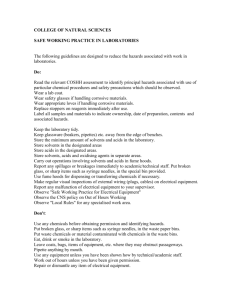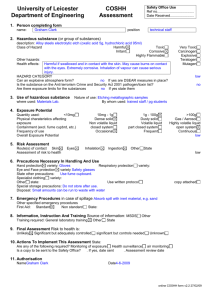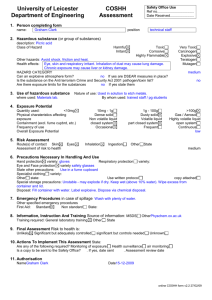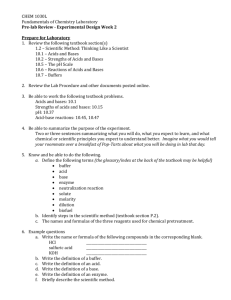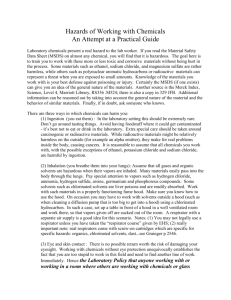Safety Rules for Biophysics teaching laboratory
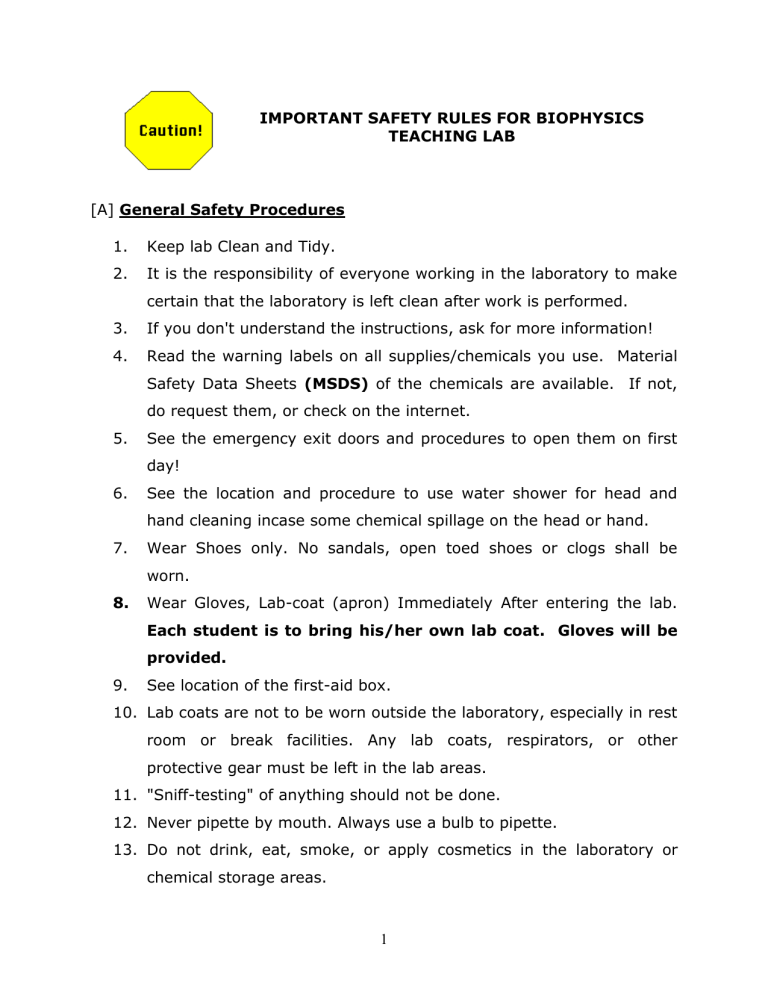
IMPORTANT SAFETY RULES FOR BIOPHYSICS
TEACHING LAB
[A] General Safety Procedures
1.
Keep lab Clean and Tidy.
2.
It is the responsibility of everyone working in the laboratory to make certain that the laboratory is left clean after work is performed.
3.
If you don't understand the instructions, ask for more information!
4.
Read the warning labels on all supplies/chemicals you use. Material
Safety Data Sheets (MSDS) of the chemicals are available. If not, do request them, or check on the internet.
5.
See the emergency exit doors and procedures to open them on first day!
6.
See the location and procedure to use water shower for head and hand cleaning incase some chemical spillage on the head or hand.
7.
Wear Shoes only. No sandals, open toed shoes or clogs shall be worn.
8.
Wear Gloves, Lab-coat (apron) Immediately After entering the lab.
Each student is to bring his/her own lab coat. Gloves will be provided.
9.
See location of the first-aid box.
10.
Lab coats are not to be worn outside the laboratory, especially in rest room or break facilities. Any lab coats, respirators, or other protective gear must be left in the lab areas.
11.
"Sniff-testing" of anything should not be done.
12.
Never pipette by mouth. Always use a bulb to pipette.
13.
Do not drink, eat, smoke, or apply cosmetics in the laboratory or chemical storage areas.
1
14.
No food, beverage, tobacco, or cosmetics products are allowed in the laboratory or chemical storage areas at any time. Cross contamination between these items and chemicals or samples is an obvious hazard and should be avoided.
15.
Do not use ice from laboratory ice machines for beverages.
16.
Wash promptly whenever a chemical has contacted the skin. Know what you are working with and have the necessary cleaning/neutralization material on hand and readily available.
17.
In case of accidentally damaging anything in the experiments, please report to lab-officer promptly.
18.
Don't make up your own experiments. Follow the instructions given in the lab manual for assigned experiments.
19.
Never pour or scoop directly from your primary supply into your experimental equipment.
20.
In experiments which call for combining water with other chemicals, always use distilled or de-ionized water. Tap water contains minerals and chlorine which can contaminate your results.
After experiments:
1.
Clean all the glass vessels you have and put them on the shelf in a proper order.
2.
Clean & put back apparatus after used.
3.
Wipe and clean the table and all surfaces including the fume cupboard.
4.
Put all chemicals back to their respective places.
5.
Put all common kits and tools to their designated places.
6.
Keep your samples in the designated place and label your sample by sample’s name, your name, and the date on the vessel.
7.
Keep all your stuffs in own tool box.
2
8.
Check the power switches of all the equipment.
9.
Ensure all lights are off (fume cupboard + switch to unoccupied).
10.
Ensure the lab is properly locked.
Offenders of any rules will be barred from the lab and appropriate action will be taken.
[B] Chemical Safety Procedures:
1) Chemical Spills:
It shall be cleaned immediately with the help of lab-officer or lecturer available. Water spills can create a hazard because of the slip potential and flooding of instruments (particularly on the floor below.) Small spills of liquids and solids on bench tops shall be cleaned immediately to prevent contact with skin or clothing. Always clean up spills promptly. Dilute corrosive chemicals with water first. Add baking soda to acids, and vinegar to bases to neutralize them before mopping up. Seek help from lab-officer to do. Do not do alone.
2) Volatile Solvents:
Volatile solvents can pose inhalation, skin, and ingestion hazards. Some of the solvents may also be flammable, which could cause fire and/or explosion hazards. Whenever possible, use volatile solvents in a properly operating fume hood to eliminate inhalation hazards, use correct skin and eye protection and use good laboratory and hygienic technique to eliminate any possible ingestion of volatile solvents.
3
3) Acid and Bases: i) Always pour acids slowly into water. Never pour water into concentrated acids. ii) Common to all acids and bases is their corrosive action on human tissues.
Minor exposures are generally reversible, although often painful for a short period of time. The reversibility of the effects of acid or base exposure will depend on three factors: the duration of exposure, concentration of the material, and the first aid methods used. iii) Exposure can occur through skin absorption or inhalation. With inhalation exposure, remove the victim from the area (try to keep the victim from breathing too deeply, as this may exacerbate the effects) and summon medical help. iv) Skin contact is the most common route of exposure. Here the concentration and type of acid are the most important factors. In concentrated forms, all types of corrosives may cause severe penetrating burns. Dilute solutions do not have the same warning properties as concentrated forms, so guard against exposure. One should be particularly careful with hydrofluoric acid v) When using or dispensing concentrated acids or bases, a lab coat or apron and a full face shield is required. vi) If there is skin or eye contact with acids or bases, make sure to flush the area with water for 15 to 30 minutes and summon medical assistance.
4
vii) Use saturated sodium carbonate or calcium carbonate solution to neutralize inorganic acids such as HCl until the pH is between 5 and 10 in case of spillage on hands. Do not use on face. viii) Use plenty of water in case of inorganic base (like NaOH) spillage on the body. ix) Use pH paper to analyze the spill.
4) Toxic Solids:
Many of the chemicals used in the laboratory that are solid and toxic are used in solution, so skin absorption can be of a concern. This is particularly true when a substance is dissolved in a solvent which can penetrate the skin.
Also, an oxidizing material dissolved in water can act directly on the skin causing irritation where the solid alone would be relatively less irritating. It is therefore important that proper personal protective equipment be worn.
In the solid form, the greatest risk of exposure is through inhalation. This risk can be lessened by wearing the appropriate respirator and/or working in a fume hood.
5
